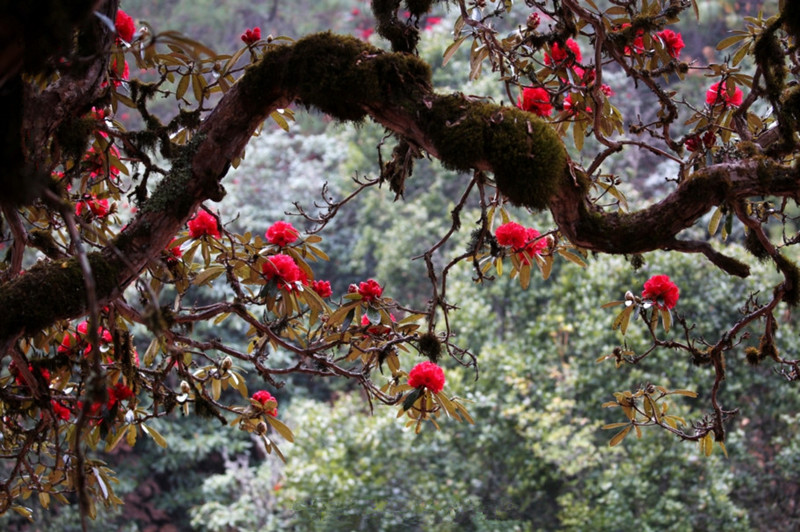- Chinese Name: 苍山西坡
- Location: Dali (大理), Yunnan Province (云南省)
- Climate: Subtropical alpine climate
- Protected Species: Taxus wallichiana (云南红豆杉), Magnolia delavayi (滇藏木兰), Manglietia hookeri (红花木莲)
Landscape Structure
The Western Slope of Cangshan (苍山西坡) features a more extensive vertical climate range than the eastern slope, resulting in distinct vegetation zones. It includes plant types from the quasi-subtropical to desert zones, making it the most biodiverse part of the Cangshan range. The botanical composition reflects elements from four major plant regions: the Qinghai-Tibet Plateau (青藏高原), Yunnan-Guizhou Plateau (云贵高原), Western Yunnan Valleys (滇西峡谷), and the Upper Reaches of the Lancang and Yuanjiang Rivers (澜沧江元江上游).
Cangshan harbors over 6,000 plant species, of which 2,849 have been identified and classified into 927 genera and 182 families. Nearly 40 species belong to the Rhododendron genus. There are 26 endangered species under national protection, including 4 in Category II and 10 in Category III. Additionally, there are 3 species endemic to China, 4 to Yunnan, and 5 unique to Cangshan.
Notable Flora

Some representative plant species include:
Rhododendron sanguineum (似血杜鹃), Rhododendron densiflorum (密枝杜鹃), Rhododendron daliense (大理杜鹃), Abies delavayi (苍山冷杉), Rhodiola (红景天), Fargesia (冷箭竹), Cupressus chengiana (曲枝柏), Rhododendron oreotrephes (火红杜鹃), Rhododendron racemosum (团花杜鹃), Tsuga dumosa (云南铁杉), Taxus wallichiana (红豆杉), Acer (槭), wild cherry (野樱), Sorbus (花楸), Illicium (野八角), Edgeworthia chrysantha (领春木), Rhododendron mucronulatum (突尖杜鹃), Rhododendron sulphureum (硫磺杜鹃), Rhododendron yunnanense (云南杜鹃), Rhododendron leptanthum (兰果杜鹃), Pinus armandii (华山松), Pinus yunnanensis (云南松), Schima superba (银木荷), Quercus serrata (石栎), Cyclobalanopsis glauca (青冈栎), Castanopsis echinocarpa (元江栲), Rhododendron charmingia (迷人杜鹃), Rhododendron dew (露珠杜鹃), Rhododendron leptophyllum (薄叶杜鹃), Cinnamomum (樟), Brugmansia suaveolens (旱冬瓜), Pterocarya stenoptera (枫杨), walnut (核桃), Keteleeria evelyniana (滇油杉), Rhododendron simsii (马缨花), camellia (山茶花), Quercus aliena (麻栎), Rhododendron decorum (大白花杜鹃), Ficus (榕), wild citrus blossom (野香橼花), Symplocos (小铁子), Bombax ceiba (木棉), Fargesia (龙竹), and wild banana (野芭蕉).
Historical Background
In 1993, the Yunnan Provincial Government designated Shimen Pass (石门关) on Cangshan as a provincial-level scenic spot under document Yunzhenfa [1993] No. 199.
In 1994, the State Council designated the Cangshan-Erhai region (苍山洱海) as a national-level nature reserve under document Guofa [1994] No. 26.
Vegetation and Glacial Heritage
The glacial relics of Cangshan are a major conservation focus within the nature reserve. In 1937, geologist H. Fissment proposed the theory of a “Dali Glacial Period.” In 1972, renowned Chinese geologist Li Siguang suggested that another glacial period occurred in China after the Lushan glacial period of the Quaternary. The concept of the Dali Glacial Period is now widely accepted and considered the last glacial period of the Quaternary in China. This has great scientific, educational, exploratory, and touristic value for understanding the Earth’s evolution, ecological environment, physical geography, and geological features.

 7 Days GolfingTour
7 Days GolfingTour
 8 Days Group Tour
8 Days Group Tour
 8 Days Yunnan Tour
8 Days Yunnan Tour
 7 Days Shangri La Hiking
7 Days Shangri La Hiking
 11 Days Yunnan Tour
11 Days Yunnan Tour
 6 Days Yuanyang Terraces
6 Days Yuanyang Terraces
 11 Days Yunnan Tour
11 Days Yunnan Tour
 8 Days South Yunnan
8 Days South Yunnan
 7 Days Tea Tour
7 Days Tea Tour
 8 Days Muslim Tour
8 Days Muslim Tour
 12 Days Self-Driving
12 Days Self-Driving
 4 Days Haba Climbing
4 Days Haba Climbing
 Tiger Leaping Gorge
Tiger Leaping Gorge
 Stone Forest
Stone Forest
 Yunnan-Tibet
Yunnan-Tibet
 Hani Rice Terraces
Hani Rice Terraces
 Kunming
Kunming
 Lijiang
Lijiang
 Shangri-la
Shangri-la
 Dali
Dali
 XishuangBanna
XishuangBanna
 Honghe
Honghe
 Kunming
Kunming
 Lijiang
Lijiang
 Shangri-la
Shangri-la
 Yuanyang Rice Terraces
Yuanyang Rice Terraces
 Nujiang
Nujiang
 XishuangBanna
XishuangBanna
 Spring City Golf
Spring City Golf
 Snow Mountain Golf
Snow Mountain Golf
 Stone Mountain Golf
Stone Mountain Golf

















